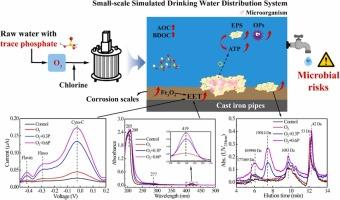臭氧化预处理和微量磷酸盐对模拟饮用水配水系统水质、健康风险和微生物稳定性的协同效应
IF 11.3
1区 环境科学与生态学
Q1 ENGINEERING, ENVIRONMENTAL
引用次数: 0
摘要
饮用水输配系统(DWDS)中致病菌的增殖和耐氯性对人类健康构成严重威胁。本研究采用生物膜环形反应器模拟铸铁试样,考察了臭氧预处理和微量磷酸盐对水质健康风险和微生物稳定性的协同作用。结果表明,对含有微量磷酸盐的饮用水进行臭氧处理相当于增加微生物的碳源和磷源,进一步导致机会性病原体(OPs)在后续的 DWDSs 中迅速增殖。在臭氧预处理和 0.6 mg/L 磷酸盐的进水条件下,活军团菌属、分枝杆菌属和棘阿米巴属的基因拷贝数分别高达 1.50×104、1.21×104 和 2.29×104 个基因拷贝/毫升。DWDSs 中悬浮生物膜的胞外高分子物质含量更高、分子量更大、絮凝效率更高,有助于提高微生物的耐氯性。同时,腐蚀产物中出现了更多的 Fe3O4,这增强了通过细胞色素 c 的胞外电子传递,削弱了 DWDSs 中腐蚀产物与微生物之间的静电排斥。最后,DWDSs 中的 OP 生长和微生物代谢活动更加活跃。这项研究表明,臭氧预处理和微量磷酸盐分别作为一种绿色技术和一种不起眼的营养物质,会在后续的 DWDS 中引发重大的微生物健康风险。因此,在自来水厂使用臭氧技术时,尤其是在没有生物过滤处理工艺的情况下,应更加严格地限制饮用水中的磷酸盐。本文章由计算机程序翻译,如有差异,请以英文原文为准。

Synergistic effects of ozonation pretreatment and trace phosphate on water quality health risk and microbial stability in simulated drinking water distribution systems
The proliferation and chlorine resistance of pathogenic bacteria in drinking water distribution systems (DWDSs) pose a serious threat to human health. In this study, the synergistic effects of ozonation pretreatment and trace phosphate on water quality health risk and microbial stability were investigated in the small-scale DWDSs simulated by biofilms annular reactors with cast iron coupons. The results indicated that ozonation of drinking water containing trace phosphate was equivalent to increasing microbial carbon and phosphorus sources, further leading to the rapid proliferation of opportunistic pathogens (OPs) in subsequent DWDSs. Under the influent condition of ozonation pretreatment and 0.6 mg/L phosphate, the gene copy numbers of living Legionella spp., Mycobacterium spp., and Acanthamoeba spp. reached up to 1.50×104, 1.21×104, and 2.29×104 gene copies/mL, respectively. The extracellular polymeric substances from suspended biofilms in DWDSs exhibited higher content, molecular weight, and flocculating efficiency, contributing to the improvement of microbial chlorine resistance. Meanwhile, more Fe3O4 appeared in the corrosion products, which enhanced the extracellular electron transfer via cytochrome c and weakened the electrostatic repulsion between corrosion products and microbes in DWDSs. Finally, more active OP growth and microbial metabolic activity occurred in DWDSs. This study revealed that ozonation pretreatment and trace phosphate, as a green technology and an inconspicuous nutrient, respectively, can trigger significant microbial health risks in subsequent DWDSs. Therefore, the phosphate in drinking water should be more strictly restricted when ozonation technology is used in waterworks, especially without a biofiltration treatment process.
求助全文
通过发布文献求助,成功后即可免费获取论文全文。
去求助
来源期刊

Journal of Hazardous Materials
工程技术-工程:环境
CiteScore
25.40
自引率
5.90%
发文量
3059
审稿时长
58 days
期刊介绍:
The Journal of Hazardous Materials serves as a global platform for promoting cutting-edge research in the field of Environmental Science and Engineering. Our publication features a wide range of articles, including full-length research papers, review articles, and perspectives, with the aim of enhancing our understanding of the dangers and risks associated with various materials concerning public health and the environment. It is important to note that the term "environmental contaminants" refers specifically to substances that pose hazardous effects through contamination, while excluding those that do not have such impacts on the environment or human health. Moreover, we emphasize the distinction between wastes and hazardous materials in order to provide further clarity on the scope of the journal. We have a keen interest in exploring specific compounds and microbial agents that have adverse effects on the environment.
 求助内容:
求助内容: 应助结果提醒方式:
应助结果提醒方式:


